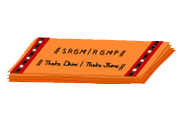Posted By: Administrator
Rāga: Rāgamālikā
Tāḷa: Miśhrachāpu
Composer: Tanjore Quartet
Language: Thelugu
Meaning – Word by
word: ?
Meaning –
Overall: Team Ambalam
Alignment,
Diacriticals & consequent spelling changes, Language & grammar editing,
if any and necessary, of existing meaning: Team Ambalam
Pallavi:
Gokulāmbudhi Chandhra Sundhara Gopikājana Brindha
Śhubhakara
Gopaveśhadhhara Abhhayaṅkara Kaugalinchu Guṇakara
Charaṇam 1
Mandhahāsamu Pādhāravindhamu Kundha Mādhhava
Nandhaka Muni Brindha Nuthu Govindha Vandhyuḍa Santhathambuna Jenthura
Charaṇam 2
Chāla Ninnune Korivacchiti Chārarasika Śhironmaṇi
Ikanela Thāmasayalara
Ghanaśhyāmala Thāla Jālara
Charanam 3
Kunkumāṅgitha Kumbhha Kuchadhhara Kambu Kandhara
Kinchugāthra
Kommara Ninnu Chovicchera Karunimchara Krishna Dhevarāya.
Meaning:
Gokulāmbudhi Chandhra Sundhara Gopikājana Brindha
Śhubhakara
Gopaveśhadhhara Abhhayaṅkara Kaugalinchu Guṇakara
Gokulāmbudhi: The Ocean Like Gokula Clan
Chandhra – The Moon;
Sundhara- Beautiful
Gopikājana Brindha - Cow-Herd Girl; 'Surrounded By Many People
Shubhakara – Beneficent
Gopaveśhadhhara
- Donned The Form Of A Cowherd
Abhhayaṅkara
- 'One Who Provides Safety'
Kaugalinchu
– To Embrace
Guṇakara - 'Mine Of Virtues'
You are like the beautiful moon to the ocean like
Gokula clan and surrounded by the cowherd girls. You are the one, who is a mine
of virtues and who provides safety to us having donned the form of a cowherd.
Mandhahāsamu Pādhāravindhamu Kundha Mādhhava
Nandhaka Muni Brindha
Nuthu Govindha Vandhyuḍa Santhathambuna Jenthura
Mandhahāsamu
- Charming/Pleasant/ Gentle Smile
Mukunda - 'Giver Of Freedom'
Mādhhava - Lord Of Fortune And Also Slayer Of The
Demon Madhu
Nandhaka - Name Of Krishna’s Sword.
Muni –
Sages
Vrinda - 'Surrounded By Many
Govindha - Friend Of The Cows, He Who Pleases The
Cows
Vandhyuḍa
– Saluted By
Santatham – Ceaselessly
O slayer of the demon Madhhu, who has a pleasant
smile, surrounded by many, friend of the cows & cowherds, I salute you
ceaselessly.
Note: The 5 Weapons Of Vishnu Have Particular Names
And "Nandhaka" Is Indeed The Name Of His Sword. The Other Names Are:
Chakram – Sudarśhana; Shankhham – Pānchajanya; Bow – Sharṅga; Mace (Gadha) -
Kaumodhaki
Chāla Ninnune Korivacchiti Chārarasika Śhironmaṇi
Ikanela Thāmasayalara
Ghanaśhyāmala Thāla Jālara
Chāla - 'Too Much' ;
Ninnune – You
Kori – Seek ;
Vacchithi – Came
Chāra– Girl
Rasika - One Who Can Enjoy The Rasa
[Aesthetic Emotion]
Śhironmaṇi - Excellence Or The Highest Quality'
Ikanela – Now, Why?
Thāmasayalara
- Tamas – Laziness; Yalara – Why
Ghanaśhyāmala - "Stormy Skies" Or
"Dark Heavens" ("Shyam" For "Dark" And
"Ghana" For "Sky").
(Lord Krishna Was So Nicknamed Because Of His
Dark Complexion.)
Thāla Jālara – Cannot Bear
The girls seek you a lot as you are an excellent
charmer; why this laziness to come now, O dark complexioned one?
Kunkumāṅgitha Kumbhha Kuchadhhara Kambu Kandhara
Kinchugāthra
Kommara Ninnu Chovicchera Karunimchara Kriṣhṇa Dhevarāya.
Kunkumāṅgitha – Red Color Vermillion; Ankita -
'With Auspicious Marks'
Kumbhha – Pot Like
Kuchadhhara – Chest
Kambu – Conch; Kandhara – Neck
Kinchu – Small;
gāthra- Body
Kommara – Name Of A place In West Godavari
District In Andhra Pradesh State Of India
Ninnu - You
Chovi – That women
cchera – Will U Give
Karuninchara – Be Compassionate
Krishna Dhevarāya – Name Of The King
You wear a red coloured auspicious mark, your
neck resembles a conch; your chest is like that of a pot; you have a trim body;
be compassionate to the women, O Kriṣhṇa Dhevarāya.












